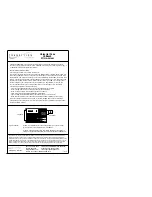
MDS
SDM9
Quick
Start
Guide
(x790
Mode)
2.2.1 LED Functions
Figure 5. LED Status Indicators
Table 1: Description of LED Status Indicators
POWER
: Green Continuous—Power applied, no problems
detected.
ALARM
: Red Flashing (5x-per-second) Alarm Indication
ACTIVE
: Blue Continuous – Transceiver is operational
TX
: Blue Flashing/Continuous – This LED illuminates
whenever the transmitter is active
2.2.2 Antenna SWR Check
Before placing the unit in final operation, the antenna
system’s standing wave ratio (SWR) should be
checked using a wattmeter suited to the frequency of
operation. High SWR (above 2:1) may indicate an
antenna or feedline problem, and should be
corrected.
2.2.3 RSSI Check (for SD Remotes)
Use the
RSSI
command (received signal strength
indication), command to check for adequate signal
strength. The radio must be receiving a signal from
the associated Master Station (LINK LED on or
blinking). In general, signal levels stronger than –80
dBm will provide reliable communication and allow for
a degree of “fade margin.” Optimize the RSSI at
Remotes by slowly adjusting the direction of the
station antenna. Watch the RSSI indication for several
seconds after making each adjustment so that the
RSSI accurately reflects any change in signal
strength. With RSSI reading, the less negative the
number, the stronger the incoming signal (
i.e.,
-70
dBm is stronger than -80 dBm).
All radios in the network must meet the following
requirements for proper operation. Check these items
first when troubleshooting a communication problem:
• Adequate and stable primary power
• Secure cable connections (RF, data and power)
• A clear transmission path between Master and each
Remote
• An efficient and properly aligned antenna system
providing adequate received signal strength.
• Proper programming of the transceiver’s parameters
• The correct interface between the transceiver and
the connected data equipment (correct cable wiring,
proper data format, timing, etc.)
3.1 LEDs
The radio’s LED indicator panel provides useful
information when troubleshooting a system problem.
Refer to
Table 1
for LED information.
3.2 Event Codes
When an alarm condition exists, the transceiver
creates a message that can be read on a connected
PC by using the
ALARM
command. Consult the
SD
Reference Manual
for further details.
3.2.1 Types of Alarms
Minor Alarms—
report conditions that, under most
circumstances, will not prevent transceiver operation.
These include out-of-tolerance conditions, baud rate
mismatches,etc. The cause of these alarms should be
investigated and corrected to prevent system failure.
Major Alarms
—report serious conditions that
generally indicate a hardware failure, or other
abnormal condition that will prevent (or hamper)
further operation of the transceiver. Major alarms may
require factory repair. Contact your factory
representative for assistance.
Power
Alarm
TX
Active
3.0 TROUBLESHOOTING






















